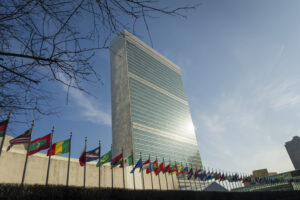Forgotten Surrogate Mothers: The Unresolved Issues in Commercial Surrogacy

In April of 2015, Gilad and Amir Greengold, an Israeli couple, landed in Nepal’s Tribhuvan International Airport in Kathmandu, an arrival that marked the beginning of the rest of their life. The couple soon met their newborn, premature babies. The babies’ surrogate mother would soon sign legal documents in accordance with her contractual agreement that forever waived her right to be in the newborns’ lives. This contractual agreement is nothing novel, in fact repeated every year in the international commercial surrogacy (ICS) industry.
Commercial surrogacy began in the 1980s with the first paid surrogacy arrangement that ended in the infamous Baby M case. The industry as a whole has only blossomed since. Currently, ICS is a booming industry worth $14 billion at the end of 2022 and is expected to reach $129 billion by 2032.
In general, the standard practice of international surrogacy involves commissioned parents paying surrogacy agencies who then, if necessary, provide an egg from a list of donor options. An egg, sperm, or both – depending on the needs of the intending parent – is provided and used to create an embryo. This is then artificially inseminated into a contracted surrogate mother.
International Debate
The ethics of ICS have long been debated and the industry is no stranger to legislative blows and stringent regulatory measures which reflect concerns of exploitation, ethical quandaries, and intricate legal issues within the system. The debate of ICS hangs around the typical breakdown of practice. Individuals or couples from wealthy countries, like the United States, Canada, and China, seek the services of surrogacy agencies who recruit surrogate mothers in lower income nations like India, Cambodia, Columbia, and Mexico. This dynamic fuels arguments around exploitation of the surrogate mother’s socioeconomic status for the financial gain of surrogate agencies.
Across the globe, countries have taken action to crack down on commercial surrogacy. Several European nations have largely forbidden commercial surrogacy, including France, Germany, Italy, Bulgaria, Spain, and Norway. Beyond Europe, countries like Taiwan, Australia, and the United Kingdom have instituted legal frameworks that permit altruistic surrogacy, the surrogate mother does not receive monetary compensation, while expressly banning commercial arrangements. Critics of commercial surrogacy highlight the lack of comprehensive international regulation that has allowed the ICS industry to thrive. ICS agencies are left simply to play a game of whack-a-mole in search of the least regulated country to set up surrogacy shop. Examples include Nepal after India passed a 2015 law effectively banning commercial surrogacy (the 2015 law has since been updated). Nepal allowed commercial surrogacy to take place only if Nepali women were not the surrogate. After India’s ban, surrogacy agencies would transport Indian women to Nepal for the pregnancy. In 2015 Thailand, Southeast Asia’s hotspot for ICS, banned commercial surrogacy after a scandal involving the desertion of a down syndrome baby. Surrogacy agencies, despite knowing the risk, moved production to neighboring Laos where commercial surrogacy is largely unregulated. The same happened when Vietnam passed their 2015 law and operations were funneled into Laos where pregnancy clinics are still operational.

The surrogacy experience
Surrogacy agencies advertise the birth of a happy and healthy baby as the end goal. Couples are promised that their baby will be taken care of. The emphasis lies solely on the child. But what about the surrogate mother? Surrogacy agencies devote plenty of pages on their website, as well as assurance to the intending parents, that the surrogate mother will be taken care of for the health of the baby. But is this true?

Surrogate mothers are most often from poor countries or families and see surrogacy as a method of financial security. Payment for having a healthy child varies greatly between each contract and surrogacy agency but can range from $6,000 CAD to $20,000 CAD, a life-changing amount of money for low-income women. Women are usually either recruited through social networks in their communities or through online ads. Recruitment in the ICS industry traditionally consists of coercion tactics mixed with familial financial pressures rather than an educated choice on behalf of the women. Primarily in the recruitment of Indian women, the surrogate mothers will have their choices made by their husbands or socially reputable individuals within their town. As a result, women are seen primarily as financial potential rather than independent deciders. Recruiters will also misinform potential surrogates and appeal to the altruistic or religious ideals of having a child for those who can not. In the recruitment stage, the concept of choice is provided to surrogate mothers despite the reality of choice being absent from a life-altering decision.
Once recruited into the system, women are expected to sign a complex legal contract that is difficult to understand given the education and reading level of many low-income women. The surrogate mother faces challenges during her pregnancy as she is under the full control of the surrogacy agency. Some women complete their contract in agency clinics that have strict rules and result in limited physical mobility throughout the pregnancy. This clinic method is popular and one that was especially common when agencies would transport Indian women across country borders to Nepal. Similar methods still occur between other countries; Cambodian women moved to Laos, where surrogacy regulations are lax. This nine-month process results in a total separation from the surrogate mother’s family and can lead to disruptions in the relationship between both her children and husband.
Agencies promote the health care of the surrogate mother relating to her pregnancy and unborn child. But what about the health care of the surrogate mother not relating to the child? Surrogate mothers are left vulnerable to illness, as most pregnant people are, but they receive little to no treatment for it if the unborn child is unaffected. In addition, there is usually no short or long-term counselling available to surrogate mothers who are left vulnerable to mental illnesses like depression. The health care of the surrogate mother ceases after the completion of the baby transaction, resulting in the woman and her family taking on the financial onus of any postpartum health issues. Surrogate mothers are the backbone of the ICS industry but are not treated as such. The standard of medical care relies on the principle of informed consent, and the industry of surrogacy in low-income countries fails to provide consent to surrogate mothers categorically. Too often, the psychological needs of a pregnant mother before, during, and after pregnancy are neglected.
The system of international commercial surrogacy has a serious problem. Categorically, the ICS industry fails to provide substantive, digestible, and supportive care that is so vital in a process as delicate and complex as bringing humanity into existence. At its core, the International Commercial Surrogacy industry is not just a matter of supply and demand; it is about humanity itself. It is a reflection of our collective responsibility to protect the rights and dignity of all involved parties, especially mothers of any kind. Human life and commoditization are like oil and water, they do not mix.
Edited by Zoe Lister.
Featured image: “El amor no debe ser sólo una llama, sino una luz constante.” by Marcos de Madariaga is licensed under CC BY-NC-ND 2.0 DEED.
